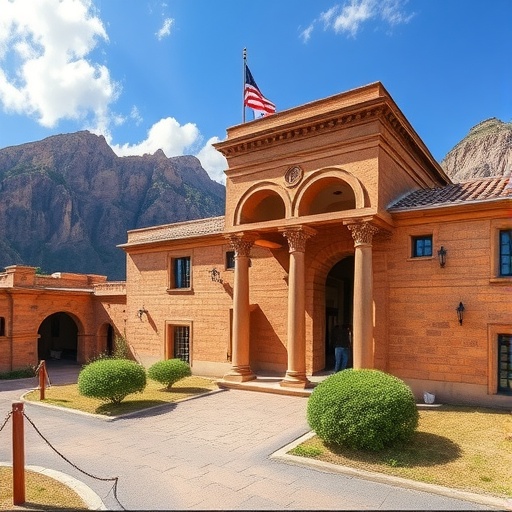For centuries, the dominant archaeological narrative has held that monumental architecture—those grand human-made structures that dominate the landscape—are the products of complex societies marked by hierarchical power structures, social stratification, and coordinated labor forces. This paradigm suggests that without institutionalized leadership or inequality, such impressive constructions could not emerge. However, recent groundbreaking research challenges this entrenched viewpoint by providing compelling evidence that hunter-gatherer groups, traditionally viewed as egalitarian and non-hierarchical, also created monumental architecture.
A new study published on June 24 in the prestigious journal Antiquity reveals that hunter-gatherers in the Peruvian Andes constructed large burial mounds at Kaillachuro, situated in the Titicaca Basin. These monumental structures predate previously known examples in the region by an astounding 1,500 years, marking the earliest evidence of monumental architecture there at roughly 5,300 years before present. This discovery not only pushes back the timeline of complex construction in the Andes but also recalibrates our understanding of early human social organization.
Luis Flores-Blanco, the corresponding author of the study and now a postdoctoral researcher at Arizona State University, emphasizes the pivotal role of ritual and communal memory of ancestors in the emergence of these structures. Conducting this research during his doctoral studies at the University of California, Davis, Flores-Blanco argues against the conventional equation of monumentality solely with elite-driven social stratification. Instead, Kaillachuro exemplifies how monumentality can arise from continuous, collective ritual without formalized inequality.
The research is further enriched by the input of co-author Mark Aldenderfer, professor emeritus at UC Merced, who first discovered Kaillachuro in 1995. The site comprises nine modestly sized mounds which were carefully examined through systematic surveys and target excavations. These efforts uncovered human remains interred alongside sophisticated stone tools, including projectile points indicative of advancing hunting technologies. Together, these artifacts weave a narrative of evolving social and technological complexity in seemingly egalitarian groups.
Radiocarbon dating—a precise method used to establish the age of ancient organic materials—was instrumental in recalibrating the chronological framework of these constructions. By examining organic remains contextualized within mound deposits, researchers pinpointed Kaillachuro’s initial mortuary activity to 5,300 calendar years ago. The enduring use of these mounds over approximately 2,000 years underscores the persistence of ritual practices and the communal importance of ancestral veneration in shaping the physical and cultural landscape.
Unlike earlier assumptions that monumental architecture necessarily symbolized centralized political power, this study posits an alternative origin rooted in ritualized acts of remembrance by hunter-gatherer communities. Early burial activity at Kaillachuro began with simple earth pits, evolving incrementally into elaborate stone masonry boxes. These boxes were periodically covered with debris accumulated from ongoing rituals, gradually building the low mounds that characterize the site. This sequence evidences a dynamic process whereby ritual memory was made manifest in the landscape itself, transforming intangible social practices into visible, enduring monuments.
Flores-Blanco highlights the concept that repeated acts surrounding the dead—interment, commemoration, and community gathering—can independently generate monumental formations. Such mounds served as loci of social memory, reinforcing communal identities without necessitating top-down authority. This form of architecture, born from shared ritual rather than coercion or hierarchy, broadens our understanding of the societal mechanisms capable of producing large-scale construction.
The researchers also explore the socio-ecological context likely facilitating this phenomenon. During the period of Kaillachuro’s use, hunter-gatherer groups may have begun semi-sedentary lifestyles, aggregating populations in stable settlements. Complemented by rudimentary food production techniques and expanding exchange networks, these conditions provided the logistical foundation for sustained ritual practice and gradual mound construction. The accompanying adoption of bow-and-arrow technology marks a critical technological advancement, influencing hunting efficiency and social organization.
Moreover, the study suggests that the communal memorialization observed at Kaillachuro exerts influence beyond the symbolic sphere. The physical presence of the mounds would have shaped interactions among living community members, potentially guiding social behavior, reinforcing shared values, and delineating sacred spaces in the environment. This interplay between material culture and social life exemplifies how architectural forms can mediate human relationships with both ancestors and the landscape.
This research adds a vital dimension to the ongoing debate about the origins and functions of monumental architecture worldwide. By providing a well-substantiated case where egalitarian societies produced enduring monumental forms, it challenges archaeologists and anthropologists to reassess the assumptions linking architectural scale and social complexity. The findings imply that monumentality may emerge through pathways emphasizing communal memory, ritual repetition, and social cohesion, rather than solely through hierarchical control.
Supported by funding from the National Science Foundation and several other foundations and institutions dedicated to advancing anthropological knowledge, this study paves the way for further inquiries into the nuanced relationships between social organization, ritual, and architectural innovation. It opens new avenues for understanding how early human societies constructed not only their physical environments but also their collective identities.
In conclusion, the Kaillachuro burial mounds demonstrate that monumental architecture is not exclusively the domain of stratified societies with elite leadership but can also arise from egalitarian groups motivated by ritual remembrance. This insight significantly enriches our comprehension of human social evolution, revealing that the desire to commemorate and connect with ancestors possesses the power to shape landscapes and societies profoundly.
Subject of Research: People
Article Title: Not provided
News Publication Date: 24-Jun-2025
Web References: http://dx.doi.org/10.15184/aqy.2025.40
References: Flores-Blanco, L., Aldenderfer, M., et al. (2025). Monumental architecture built by hunter-gatherer groups at Kaillachuro, Titicaca Basin, Peruvian Andes. Antiquity.
Image Credits: Not provided
Keywords: Social sciences




